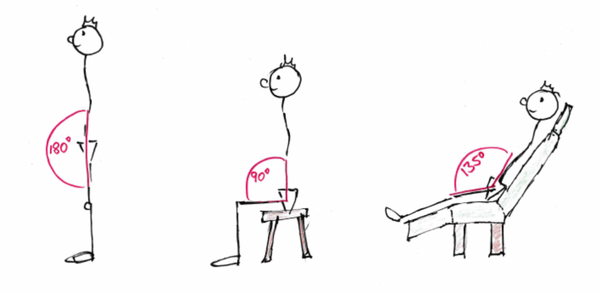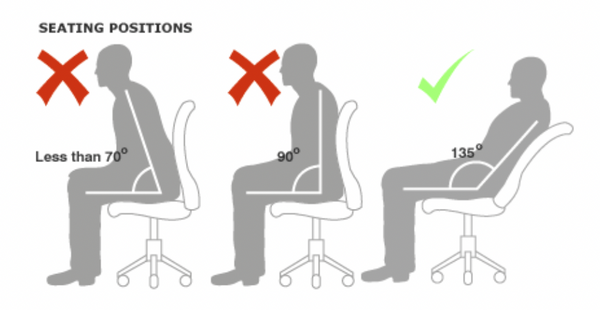Recliner chairs. What is there to know?
What to look out for in a recliner chair
-
Just like shoes they must fit you well.
-
Recliners come in different sizes, large, medium and small. Try them out in the store before buying.
-
They must have a lumbar support, of the right size and position for you.
When we sit in a reclined position the hip angle increases
The hip angle is the angle between your thigh and your torso.
-
When we stand it is 180°.
-
When we sit upright it is 90°.
-
When in a recliner chair it is much bigger about 130-140°.

Increasing hip angle
-
Reduces pressure on the back.
-
A hip angle of 135° was shown to be the ideal angle using MRI studies.Dr Waseem Bashir of the Department of Radiology and Diagnostic Imaging at the University of Alberta Hospital, Canada, reports "Sitting in a sound anatomic position is essential, since the strain put on the spine and its associated ligaments over time can lead to pain, deformity and chronic illness." (See more below [1]).
-
Takes the pressure off the intervertebral joints and discs.
-
Gives the back muscles a rest, while keeping the joints safe.
Main Take-Home Points
|
What to look out for in a recliner chair: Find the right size for you, they are made for people of different sizes. Make sure the lumbar support fits into the correct position of your back. Back pain benefits By Increasing the hip angle to 135° the load on the lumbar discs is reduced and this reduces the pressure on your spinal joints, reducing back pain. Health benefits. Improved circulation. This has many benefits including reducing the risk of varicose veins and hemorrhoids. Helps breathing by freeing up the diaphragm. This helps many systems and can reduce the onset of heartburn, hemorrhoids and varicose veins and it can improve blood pressure, digestion, and mental relaxation. Summary In general recliner chairs have been shown to be a good way of sitting when we rest. |
Increasing hip angle reduces intra-abdominal pressure (the pressure in your tummy)
- This allows the diaphragm to move downwards more freely as there is now less resistance from the abdomen. This diaphragm movement massages the stomach and liver stimulating digestion.
-
Boosts Digestion: because there is more room for your intestines to move and wriggle about (peristalsis) digestion is stimulated.
-
Reduces acid reflux and heartburn as the acidic stomach contents are not squeezed up into the windpipe.
-
Makes breathing easier: breathing can be measured with the “Breathing pattern index” [2] which, if improved, has been shown to help with chronic low back pain.
-
Helps us mentally as improving breathing also helps to relax our minds. Studies have shown breathing to be of primary importance for people with anxiety to help mental relaxation [3].
Raising legs and feet
-
Raising our feet means that it is easier to get blood back to our heart. When we walk about, it is our leg muscles that squeeze the blood back up to our heart by their rhythmic contraction. This action no longer occurs when we sit, so our blood tends to hang around in our legs for longer. This can result in swollen ankles or encourage varicose veins.
-
The next place the blood tends to get stuck is in the base of our pelvis. When we are walking about and breathing more strenuously, the diaphragm’s movement is constantly changing the intra-abdominal pressure, thus squeezing the blood out of our lower abdomen. When we sit very still, the blood likes to pool down here and this is not good as it can encourage hemorrhoids. Hemorrhoids are an occupational hazard for truck drivers for example.
-
Our heart has an easier time. When more blood returns to the heart, the heart does not have to work so hard to refill between each beat.
Summary
In general recliner chairs have been shown to be a good way of sitting when we rest, if you have the space. They are much better than sitting on a standard sofa, which have been designed to look good but have no ergonomic features.
References
[1] A more in-depth look at hip angles by Washeem Bashir 2006.
Spine to hip angles

The research was carried out at Woodend Hospital in Aberdeen.
Volunteers with healthy backs were scanned using a special MRI machine, which allowed the subjects to move, so they could sit and stand.
In this study, the subjects assumed three different sitting positions: a hunched forward position (70°), as if they were leaning over a desk or a video game console, an upright sitting position (90°); and a "relaxed" position (135°) while their feet remained on the floor.
The researchers took measurements of spinal angles and spinal disc heights.
Spinal disc movement occurs normally when weight is placed on the spine; they bulge a bit as they are flexible.
Disc bulging and reduction in disc height was found to be most pronounced with hip angles of 90° or less. It was least pronounced with the 135°.
When they looked at all test results, the researchers concluded that the 135-degree hip angle put the least load on the spinal joints for sitting.
[2]. Comparison between Some Important Breathing Pattern Index in Non-Specific Chronic Low Back Pain and Healthy Subjects.
Source: Modern Rehabilitation. 2014, Vol. 8 Issue 2, p39-45. 7p.
Author(s): Ravanbakhsh, M.; Pazhuhide, S. F.; Goharpey, Sh.
[3]. Published: 14 April 2015.
Self-Regulation of Breathing as a Primary Treatment for Anxiety.
Ravinder Jerath, Molly W. Crawford, Vernon A. Barnes & Kyler Harden Applied Psychophysiology and Biofeedback volume 40, pages107–115 (2015).